A drizzly weekend seemed like a good time to fill the house with the aroma of spices. It started out with the need to replenish our supply of Cinnamon-Raisin-Walnut Bread, my Number One Bread Fan’s favorite. Then, I wanted to bake something really special to take to our friends’ new house for a pre-dinner snack and cocktail. I settled on making a second attempt at the Cheese-Curry-Onion Bread from The Cheese Board Collective’s cookbook.
Cinnamon

Peter Reinhart’s Cinnamon-Raisin-Walnut Bread may be the bread I’ve baked more times than any other. It’s a real treat every time. I usually use a mix of walnuts and pecans, and use butter in place of shortening. And this time I decided to try it with 25% whole wheat flour, since we’ve been enjoying the flavor of whole grains lately. Besides, we have declared that whole wheat makes this a health food, so we can eat it even more often without sugar-guilt.
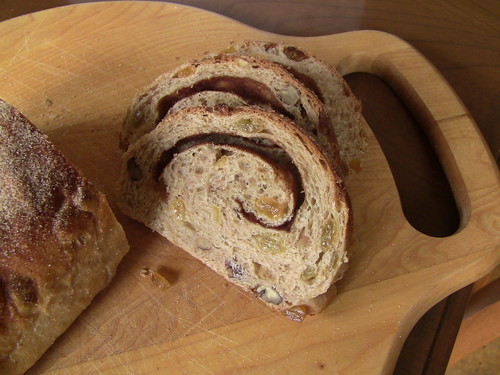
A well-balanced breakfast.
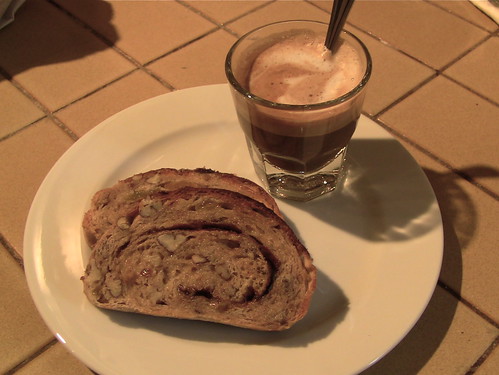
Curry

At the beginning of my baking education, I started on sourdough. The first straight dough bread I made was the Cheese-Onion-Curry Bread from Berkeley’s Cheese Board Collective. As I reported back in September, it is a bread with very special memories of my gradual school days in the ‘70s. So when my wife--as if reading my mind-- gave me The Cheese Board Collective Works as a birthday present, I immediately tried to bake a batch of taste memory. We loved it, and now six months later, I can’t believe I haven’t baked it since. It was time.
In the interim, I’ve read a lot of recipes here at TFL and elsewhere that use cheese, onions and bacon in various combinations. They usually make me drool. I decided to vary the Cheese Board’s recipe a bit. I used a combination of yellow onions and scallions, and I added some fried bacon (in our house, we call it Vitamin B), since almost everything with cheese and onions is better with bacon.
This bread is a complete meal. You start with a simple yeast bread dough with curry powder and pepper. Then add onions/scallions, chopped bacon and a full pound of cubed cheese. I used a combination of Sharp Cheddar, Jarslberg and Gruyere.
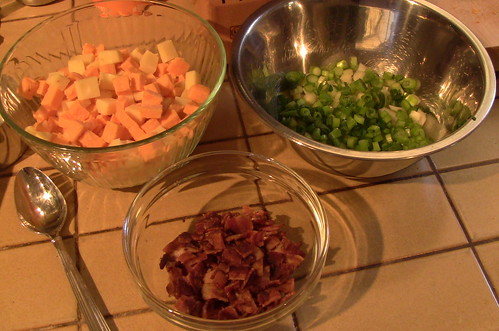
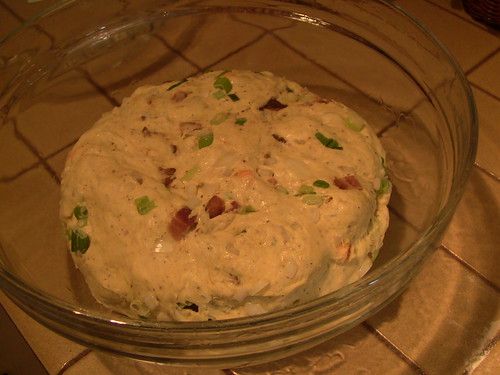
The amount of chunky stuff in the dough makes it impossible to form a smooth-skinned boule, so the loaf flattens out some in baking, but holds together with some luck. It's not a real pretty bread, but my, my, what flavor!
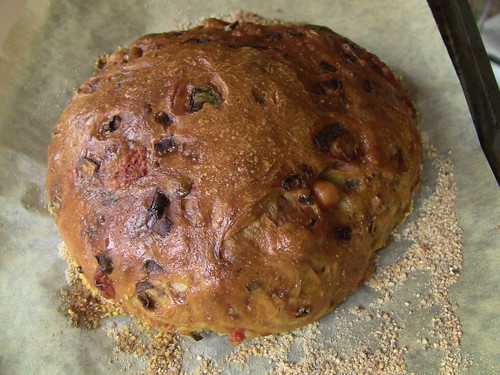
The best part is the pockets of molten cheese interspersed with the strongly cheese and curry flavored moist and tender crumb. I think the bacon flavor is barely noticeable, but my wife tells me it's there and it's good. She suggests dialing back the curry a bit so the bacon flavor comes through more. I may try that.
This is a recipe worth trying if you’re looking for a hearty meal in a loaf. I highly recommend The Cheese Board Collective Works (http://www.amazon.com/gp/search?index=books&linkCode=qs&keywords=1580084192). It's got lots of recipes for breads and morning baked goods, too.
Here’s my variation on the recipe:
Cheese Scallion Bacon Curry Bread
(adapted from Cheese Onion Curry Bread in The Cheese Board Collective Works)
Ingredients
4 cups Bread Flour 570g
1 ½ tsp Instant Yeast 5g
1 ½ tsp Black Pepper 3g
1 ½ Tbsp Curry Powder 4g
2 tsp Kosher Salt 12g
1 ¾ cups Lukewarm Water 400 g
6-8 slices Bacon, cooked and chopped
½ yellow onion plus 6 Scallions, chopped
1 pound Mixed Cheeses*, cut into ½ inch cubes
Medium yellow cornmeal (for sprinkling)
1 Egg, beaten (for glaze)
-------------------
* Any firm flavorful cheeses will do. I used a combination of sharp cheddar, Jarslberg and Gruyere. If you don’t want molten pockets of cheese in the bread, you could grate the cheese.
Procedure
In a mixing bowl, combine flour, yeast, pepper, curry powder and salt. Add water and mix until ingredients well combined.
Transfer to lightly floured board and knead until smooth and silky (10-12 minutes)
In a small bowl, toss onions and scallions with 1/2 Tbsp of flour and mix.
Flatten the dough to a one-inch thick disk and add scallions and bacon to the center. Gather the dough around the scallions and bacon and knead to incorporate (2-3 minutes).
Again flatten the dough and add cheese in center. Gather up the dough around the cheese and knead to incorporate.
Form the dough into a ball and place in an oiled bowl large enough for dough to double. Turn the dough to coat with oil. Cover the bowl with plastic wrap or a damp cloth. Let the dough rise until doubled (about 60-90 minutes at room temperature).
Sprinkle cornmeal on two baking pans.
When dough has doubled, place it on a lightly floured board and divide into three equal pieces. Shape each as a loose boule, cover with a floured dish towel and let rest for 10 minutes. (Note: with the chunks of cheese, there’s no way to get a smooth taut sheath on the loaf. Don’t sweat it).
Shape each ball into a boule and place on baking pans dusted with corn meal (I used parchment between the pan and the cornmeal). Cover the loaves with a floured dish towel and let rise until increased in size about 50% (or use poke test). This takes about 60-75 minutes at room temperature.
Pre-heat oven to 450F.
When loaves are proofed, brush with beaten egg and bake (Note: no need to slash and no need for steam).
After 10 minutes at 450F, lower temperature to 400F. Rotate baking pans as necessary to achieve even browning.
Bake a total of 35 – 40 minutes or until crust is golden brown and loaf sounds hollow when tapped on the bottom.
Remove loaves to cooling rack. Eat when not quite cool (45 minutes).
Enjoy!
Glenn
Submitting to Yeastspotting.